Those Places Thursday: Samuel J. Lee and Son Pharmacy, St. Louis, Missouri
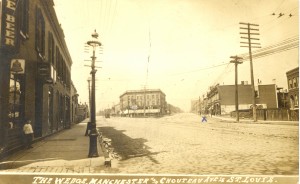
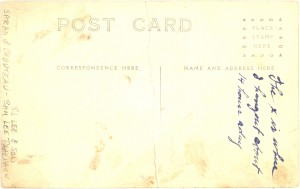



One of my most favorite places visited was Colonial Williamsburg in Virginia. At one of the taverns, there was a gentleman portraying an elderly resident of Williamsburg- he looked like Benjamin Franklin. He was probably in his seventies, and surprisingly got out of character a bit with the kids. He told them that when a young boy, his elderly neighbor had told him stories of the Civil War that he witnessed growing up. The neighbor’s parents had told their son stories of the American Revolution they lived through- and here this reenactor was, just 2 skips from the founding of our country, telling our children of those days in the voice of a Colonial Williamsburg resident. It made me realize that I was closer to my ancestors than it sometimes seemed.
I was not the only one realizing that those times were closer. About ten years ago, Maureen Taylor, who specializes in old photos and deciphering their clues, realized that there were photographs of persons who lived during the Revolutionary War! Photography was invented in 1839, so anyone over 80 years old by then would have been an adult during the Revolution; those who were children during the Revolution would have been at least 50 years old when he or she sat for a portrait after 1839. There were even surviving widows of Revolutionary soldiers in the 20th century: Esther Sumner was just 21 when she married 75 year old Noah Damon, and she died in 1906. So there are more close connections than seems possible, and Maureen has gathered some of this information and many photos into two books:
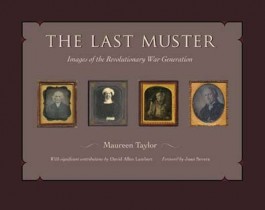
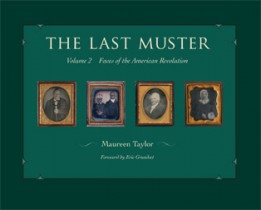
Maureen is also working on a documentary called “Revolutionary Voices”: A Last Muster Film. See her website, http://www.maureentaylor.com, for details about this project, as well as her books that can help you learn more about your family through their photographs.
The idea for this post came about during my internet ramblings- a fascinating article called, “‘Rasputin Was My Neighbor’ and Other True Tales of Time Travel” by Robert Krulwich is on the NPR website. The website includes a video of an elderly man who was attending Ford’s Theatre the fateful day that President Abraham Lincoln was shot. Yes, a video- that is just amazing!
Thinking about our ancestors, and what they witnessed in their lives, is a way to time travel while still enjoying indoor plumbing and air conditioning ;). A diary or letter, even a photo, can help us go to times past. Adding a timeline to family history research will help us to understand the story of their struggles and their lives, and if older relatives are still around, may be a springboard for stories not yet heard.
During the 1970s, as a young college woman, I was working for passage of the Equal Rights Amendment (E.R.A.). My grandmother kept up with current events and watched PBS regularly for the news shows. (She did love the gardening shows too.) One day I realized that she had been a young college woman during the time that the 19th Amendment, ‘giving’ women the right to vote, was passed and ratified. I was excited about our parallel lives and couldn’t wait to get the opportunity to ask her what she remembered- did they have a support group at college, did she write letters, debate, or even march? What did she think of the women who were beaten, jailed, starved, and force-fed because they were protesting that 51% of the American population-women- did not have civil rights?

I was dumbstruck when my incredibly hard-working, frugal, level-headed grandmother answered, “I don’t even remember that. I was so busy with my sorority and dances and clubs. And I was always having to ask my father for more money for clothes and other expenses.” Years later she showed us her college scrapbook, full of dance cards, programs, and other mementos of her busy college life that didn’t include momentous political changes.
I must say though that she DID study- and earned a degree in biology in 1922, highly unusual for a woman at that time. So she worked for equality in her own way.
So do your time travel through wonderful historical sites, like Colonial Williamsburg, but also try to place your own ancestors in the time and place they lived their ordinary lives. Try to decipher the small clues in photographs- maybe a house number on a door, or official documents such as a draft registration or passport application that gives details about color of eyes and hair, and build. Walking the farmland they ploughed, the streets they tarried on as they chatted with neighbors, and stepping foot into that one-room schoolhouse or the actual home they lived in will give you insight into what they experienced. It will bring you one step closer to their lives, and a big step closer to understanding who you are and how you became that person.
Notes, Sources, and References:
1) Maureen Taylor’s website: http://www.maureentaylor.com
The Last Muster: Images of the Revolutionary War Generation. Kent State University Press; 1 edition (July 1, 2010) ISBN-13: 978-1606350553
The Last Muster, Volume 2: Faces of the American Revolution. Kent State Univ (July 8, 2013) ISBN-13: 978-1606351826
2) “‘Rasputin Was My Neighbor’ and Other True Tales of Time Travel” by Robert Krulwich
http://www.npr.org/blogs/krulwich/2012/02/07/146534518/rasputin-was-my-neighbor-and-other-true-tales-of-time-travel
3) 19th Amendment:
http://www.archives.gov/historical-docs/document.html?doc=13&title.raw=19th%20Amendment%20to%20the%20U.S.%20Constitution:%20Women’s%20Right%20to%20Vote
http://www.archives.gov/education/lessons/woman-suffrage/
4) Sadly, women in the United States do not yet have equal protection under the law, as they do in most democratic countries- even third world countries. The Equal Rights Amendment was written by Alice Paul, a suffragist leader, right after ratification of the 19th Amendment. The 19th Amendment gave women the right to vote, but the US Constitution still did/does not offer women equal protection under the law. (And no, “men” is NOT meant to include ‘women’- if it did, women would have had the right to vote Mar 4, 1789 when the Constitution went into effect.) The Equal Rights Amendment has been introduced into Congress every year since Alice Paul wrote it, with passage in 1972 but ratification fell short 3 states in 1982. In August, 2013, a slightly altered version of the law was introduced to Congress. An excellent website concerning this issue is http://www.equalrightsamendment.org. While on that website watch the video for the upcoming film “Equal Means Equal” – it is an insightful video for this generation to understand the void in our Constitution.
Copyright 2013 by Heritage Ramblings Blog and pmm, except for the images included in this post.
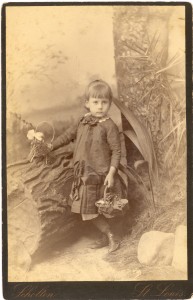
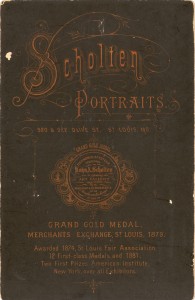
Any ideas out there of who this may be?
Please contact us if you would like higher resolution images.
Copyright 2013 by Heritage Ramblings Blog and pmm.
Samuel J. Lee was born to Samuel Lenton Lee (1849-1932) and his wife Louisa M. Brandenburger (1859-1934) in Bunker Hill, Macoupin, Illinois on 29 Jun 1879. He married Dorothy Adele Aiken (1884-1953) on 1 Dec 1906 in Bunker Hill. They moved to St. Louis, Missouri by 7 Sep 1907, when their son Lloyd Eugene Lee was born.
Sam Lee had a drugstore at 4067 Chouteau Ave. in St. Louis. When his son also became a pharmacist, the store was called “S. J. Lee & Son.”
The Lees purchased their home at 6204 Alamo in St. Louis sometime between the 1920 and 1930 censuses.
Sam died 24 Sep 1964 in St. Louis and was buried in Memorial Park Cemetery in Jennings, St. Louis Co., Missouri.
Notes, Sources, and References:
1) Birth information for Samuel J. Lee: Source Citation: Registration State: Missouri; Registration County: St Louis (Independent City); Roll: 1683856; Draft Board: 24. Source Information: Ancestry.com. U.S., World War I Draft Registration Cards, 1917-1918 [database on-line]. Provo, UT, USA: Ancestry.com Operations Inc, 2005. Accessed 12/11/13.
2) Samuel J. Lee and Dorothy Adele Aiken marriage certificate in family artifacts.
3) Birth record of Lloyd Eugene Lee: Source Information: Ancestry.com. Missouri Birth Records, 1851-1910 [database on-line]. Provo, UT, USA: Ancestry.com Operations Inc, 2007. Original data: Missouri Birth Records [Microfilm]. Jefferson City, MO, USA: Missouri State Archives. Accessed 12/11/13.
4) 1920 US Federal Census: Source Citation: Year: 1920; Census Place: St Louis Ward 24, St Louis (Independent City), Missouri; Roll: T625_960; Page: 1A; Enumeration District: 468; Image: 245. Source Information: Ancestry.com. 1920 United States Federal Census [database on-line]. Provo, UT, USA: Ancestry.com Operations Inc, 2010. Images reproduced by FamilySearch. Accessed 12/11/13.
5) 1930 US Federal Census: Source Citation: Year: 1930; Census Place: St Louis, St Louis (Independent City), Missouri; Roll: 1245; Page: 1A; Enumeration District: 0239; Image: 830.0; FHL microfilm: 2340980. Source Information: Ancestry.com. 1930 United States Federal Census [database on-line]. Provo, UT, USA: Ancestry.com Operations Inc, 2002. Original data: United States of America, Bureau of the Census. Fifteenth Census of the United States, 1930. Washington, D.C.: National Archives and Records Administration, 1930. T626, 2,667 rolls. Accessed 12/11/13.
6) Find A Grave Memorial # 56893479, http://www.findagrave.com/cgi-bin/fg.cgi?page=gr&GRid=56893479. Accessed 12/11/13.
7) Note: edited 7/2/14 and changed “George Lenton Lee” to “Samuel Lenton Lee.” George Lee was the father of Samuel Lenton Lee; Samuel’s mother was Eliza Lenton.
Please contact us if you would like higher resolution images.
Copyright 2013 by Heritage Ramblings Blog and pmm.
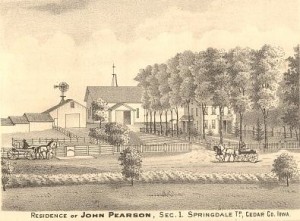
It is seldom that we can travel to a time and place long ago, and almost hear the sounds, smell the odors, touch the items in the scene, and have it seem so very real. Unless we have a diary, journal, or detailed written account such as in a county history, it is hard to imagine exactly what life was like for our ancestors.
The Agricultural Schedules of the U. S. Federal Censuses are just the vehicle to take us to a place unknown except to our ancestors. While there are still ag censuses being taken, the ones most interesting to today’s genealogists will be those taken during the 1850-1880 U. S. Federal Censuses, and for any states that also took a census in 1885. Very few of these images have been digitized, and there are also Manufacturing Schedules, Social Statistics Schedules, and even a Business schedule completed in 1935. Not all farms or businesses will be found listed, however, as the criteria for inclusion changed throughout the years, for example, in 1850, small farms producing less than $100 of products annually were excluded; in 1870, to be excluded a farm had to have less than 3 acres or produce less than $500 worth of products.
The following is a simple narrative transcription of the raw data found in the 1880 Agricultural Schedule for Wiley A. Murrell’s farm, using the column headings of the Schedule and including the data for WA’s farm. This information could easily be woven into the story of WA’s life, and that of his family, with richer language to make it a bit less dry. Also, looking at the data for other farmers on the same page will help give a sense of relative income and possessions owned by your ancestor. The Agricultural census may even help to distinguish one person from another with the same name.
JASPER COUNTY IOWA
1880 AGRICULTURAL CENSUS
MOUND PRAIRIE TOWNSHIP
Page No. 8 (D.), Supervisor’s District: No. 3, Enumeration Dist: No. 96, Line No. 6. Enumerated 08 June 1880.
W.A. MURRELL rented for shares of production 240 acres of improved land [Tilled, including fallow and grass in rotation, (whether pasture or meadow.)] and 0 acres unimproved land. The value of the farm included land, fences, and buildings worth $6,000; the value of farming implements and machinery was $300; and value of livestock was $2,200. The cost of building and repairing fences in 1879 was $50, and there was no cost for fertilizers purchased in 1879 listed.
The amount paid for wages for farm labor during 1879, including value of board was $150, with no value listed for the weeks hired labor in 1879 upon farm (and dairy) excluding housework.
The estimated value of all farm productions (sold, consumed, or on hand) for 1879 was $1600. [equivalent to about $36,000 in 2010.]
Of the farm grasslands, in 1879 30 acres were mown, 10 acres were not mown. Hay production was 40 tons, with no clover or grass seed harvested in 1879.
There were 7 horses of all ages on hand June 1, 1880 and no mules and asses.
Neat cattle and their products:
On hand June 1, 1880 were 22 working oxen, 3 milch [milk] cows, and 23 other cattle. 6 calves were dropped. [born] None were purchased, 20 cattle sold living, none listed as slaughtered, and 2 died, strayed, [or] stolen and not recovered. No milk was sold or sent to butter and cheese factories in 1879. 300 lbs. of butter were made on the farm in 1879, but no cheese.
No sheep were on the farm but it included 100 swine and 50 poultry (not barnyard) on hand June 1, 1880. 100 dozen eggs were produced on the farm in 1879.
There was no barley or buckwheat grown in 1879. The farm had 85 acres in Indian Corn, producing 4,000 bushels; 6 acres of oats which produced 225 bushels; 4 acres of rye that produced 100 bushels, and 37 acres of wheat produced 540 bushels of crop. There were no crops of pulse [legumes- soybeans], flax, or hemp. No sorghum or maple sugar was produced, nor broom corn. No hops, potatoes (Irish or sweet), tobacco, or orchard trees (apple, peach) were grown. There was no acreage in nurseries, vineyards, market gardens, or forest products (wood cut and sold or consumed) in 1879. No honey or wax was produced by bees kept on the farm in 1879.
Notes, Sources, and References:
1) To determine the non-population schedules of the US. Federal Census that are available, and where they may be found, see http://www.archives.gov/research/census/nonpopulation/
2) The FamilySearch Wiki has an article on the Agricultural Census: http://familysearch.org/learn/wiki/en/United_States_Census_Agricultural_Schedules
3) Source citation: Census Year: 1880; Census Place: Mound Prairie, Jasper, Iowa; Archive Collection Number: T1156; Roll: 25; Page: 9; Line: 6; Schedule Type: Agriculture.
Accessed online 22 May 2011: http://search.ancestry.com/iexec?htx=View&r=an&dbid=1276&iid=31643_218858-00386&fn=J ohn+M&ln=Mench&st=r&ssrc=pt_t4049043_p-1651968883_kpidz0q3d-1651968883z0q26pgz0q3d32768z 0q26pgPLz0q3dpid&pid=577872
4) Even soil fertility and differences with modern agricultural practices may be compared with these schedules. In 1880 the farm produced 4,000 bu. of Indian corn on 85 acres, for a yield of 47 bu./ac. Today’s yields, with modern planting equipment, herbicides, pesticides, and fertilizer, provide yields up to 225 bu./ac for various corn varieties.